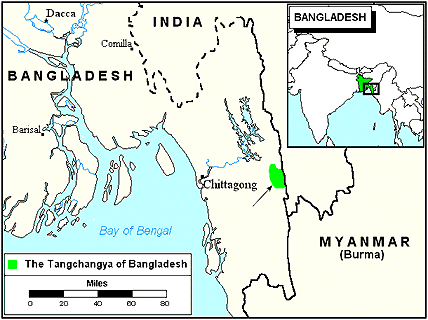|
|
Prayer Profile
The Tangchangya of Bangladesh
![[IMAGE]](../images3/0564.jpg) The Tangchangya live in the Chittagong Hills Tract district of southeastern Bangladesh. Tropical hills and mountains in this area sharply contrast the low plains of the rest of the country. The Tangchangya are a tribal people closely related to the Chakma; so closely that they are often considered a branch of the Chakma.
The Tangchangya live in the Chittagong Hills Tract district of southeastern Bangladesh. Tropical hills and mountains in this area sharply contrast the low plains of the rest of the country. The Tangchangya are a tribal people closely related to the Chakma; so closely that they are often considered a branch of the Chakma.
The Tangchangya speak an Indo-Aryan language, also called Tangchangya, that is related to Bengali. Because the Tangchangya are more assimilated into mainstream Bangladeshi culture than many other tribal groups, many of them speak Bengali as a second language.
The Tangchangya have been governed by several powers over the last century. They were controlled by Britain until 1947, then by Pakistan until 1971. Today, they are an independent nation. A flood of Bengali immigrants from the severely overcrowded plains means that the Tangchangya are rapidly becoming a minority in their own land.
What Are Their Lives Like?
The Tangchangya are primarily farmers. Traditionally, they practiced the "slash and burn" method, which was generally used in the highest parts of the hills. A small tract of forest would be cut down, the debris burned, and a variety of crops planted. The Bangladeshi government has long discouraged slash and burn agriculture; therefore, many Tangchangya now use irrigation and plow cultivation in the low hills and lowland areas.
Rice is the primary crop, although cotton, cucumbers, pumpkins, yams, maize, and a wide variety of tropical fruits are also grown. The main agricultural tool is the dao, which is a long knife similar to a machete. The dao is used in nearly every aspect of life, from building houses to harvesting crops. Common livestock includes cattle, water buffalo, pigs, goats, and sheep. Nearly all Tangchangya keep dogs.
Tangchangya homes are built on wooden or bamboo poles that reach about six feet above the ground. Bamboo is used to make the walls and is also used in the construction of the roofs. Only a few homes have tin roofs.
The Tangchangya men work in the fields while the women cook, care for children, clean house, draw water, weave, and wash clothes. The women also help the men in the fields and the men assist in caring for children.
The basic family unit among the Tangchangya is the nuclear family. Although polygamy (multiple spouses) is accepted, it seldom occurs. Marriages are usually arranged by the parents, but the opinions of the young man and woman are taken into consideration. Most of the tribes living in the hills forbid endogamy, which is marrying within one's own family or clan.
What Are Their Beliefs?
Like most of the tribal peoples of the Chittagong Hill Tracts, the Tangchangya are Buddhist. They follow the Theravada branch of Buddhism, but elements of Hinduism and animism (belief that non-living objects have spirits) can be found in their religious practices. The Tangchangya believe that there are many spirit beings, which are either helpful or harmful to humans. Exorcists and priests (shamans), called baidyo, are believed to mediate between people and the spirit world through incantations, charms, and spirit possession.
What Are Their Needs?
Bangladesh is an impoverished nation. Like most Bangladeshi, the Tangchangya are mostly illiterate and suffer from poor health care. The average income is less than $200 per year. In addition, the Tangchangya are being forced from their land by an influx of Bengali settlers.
The Tangchangya are bound by Buddhism and animism. A few missions agencies are working among them, but there are few tools for reaching these tribes with the Gospel. Neither the Bible nor the Jesus film has been translated into their native language; and there are no Christian radio broadcasts currently being aired in their language. Intercession is needed to break down the walls that hold these precious tribes captive.
Prayer Points
- Ask the Lord of the harvest to send forth laborers into Bangladesh to minister life to the Tangchangya.
- Ask the Holy Spirit to grant wisdom and favor to the missions agencies that are targeting the Tangchangya.
- Pray for the availability of the Bible, the Jesus film, and radio broadcasts in Tangchangya.
- Pray that God will reveal Himself to the Tangchangya through dreams and visions.
- Pray that God will give the Tangchangya believers boldness to share Christ with their own people.
- Take authority over the spiritual principalities and powers that are keeping the Tangchangya bound.
- Ask God to raise up prayer teams who will begin breaking up the spiritual soil of Bangladesh through worship and intercession.
- Ask the Lord to bring forth a triumphant Tangchangya church for the glory of His name!

Statistics
Latest estimates from the World Evangelization Research Center.
THE PEOPLE
- People name: Tangchangya
- Country: Bangladesh
- Their language: Tangchangya
- Population:
- Largest religion:
- Christians: 1%
- Church members: 235
- Scriptures in their own language: None
- Jesus Film in their own language: None
- Christian broadcasts in their own language: None
- Mission agencies working among this people: 0
- Persons who have heard the Gospel: 3,800 (17%)
- Persons who have never heard the Gospel: 19,700 (83%)
THEIR COUNTRY
- Country: Bangladesh
- Population:
- Major peoples in size order:
- Major religions:
- Number of denominations: 43
© Copyright 1997
Bethany World Prayer Center
This profile may be copied and distributed without obtaining permission
as long as it is not altered, bound, published
or used for profit purposes.
![[HOME BUTTON]](../graphics/home.jpg)
![[CALENDAR BUTTON]](../graphics/calico.jpg)
![[LIST BUTTON]](../graphics/listico.jpg)
[Home]
[Calendar]
[Country List]
|